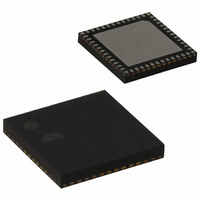EM357-RTR Ember, EM357-RTR Datasheet - Page 52

EM357-RTR
Manufacturer Part Number
EM357-RTR
Description
IC RF TXRX ZIGBEE 192KB 48QFN
Manufacturer
Ember
Specifications of EM357-RTR
Frequency
2.4GHz
Data Rate - Maximum
250kbps
Modulation Or Protocol
802.15.4 Zigbee
Applications
General Purpose
Power - Output
5dBm
Sensitivity
-100dBm
Voltage - Supply
2.1 V ~ 3.6 V
Current - Receiving
26mA
Current - Transmitting
31mA
Data Interface
PCB, Surface Mount
Memory Size
192kB Flash, 12kB RAM
Antenna Connector
PCB, Surface Mount
Operating Temperature
-40°C ~ 85°C
Package / Case
48-QFN
Lead Free Status / RoHS Status
Lead free / RoHS Compliant
Other names
636-1011-2
Available stocks
Company
Part Number
Manufacturer
Quantity
Price
Company:
Part Number:
EM357-RTR
Manufacturer:
SILICON
Quantity:
3 000
Part Number:
EM357-RTR
Manufacturer:
SILICON
Quantity:
20 000
- Current page: 52 of 245
- Download datasheet (12Mb)
6.5.3
By default the low-frequency internal RC oscillator (OSCRC) is running during deep sleep (known as deep
sleep 1).
To conserver power, OSCRC can be turned of during deep sleep. This mode is known as deep sleep 2. Since the
OSCRC is disabled, the sleep timer and watchdog timer do not function and cannot wake the chip unless the
low-frequency 32.768 kHz crystal oscillator is used. Non-timer based wake sources continue to function. Once
a wake event does occur, OSCRC is restarted and comes back up.
6.5.4
The debugger communicates with the EM35x using the SWJ.
When the debugger is logically connected, the CDBGPWRUPREQ bit in the debug port in the SWJ is set, and
the EM35x will only enter deep sleep 0 (the Emulated Deep Sleep state). The CDBGPWRUPREQ bit indicates
that a debug tool is logically connected to the chip and therefore debug state may be in the system debug
components. To maintain the debug state in the system debug components only deep sleep 0 may be used,
since deep sleep 0 will not cause a power cycle or reset of the core domain. The CSYSPWRUPREQ bit in the
debug port in the SWJ indicates that a debugger wants to access memory actively in the EM35x. Therefore,
whenever the CSYSPWRUPREQ bit is set while the EM35x is awake, the EM35x cannot enter deep sleep until
this bit is cleared. This ensures the EM35x does not disrupt debug communication into memory.
Clearing both CSYSPWRUPREQ and CDBGPWRUPREQ allows the EM35x to achieve a true deep sleep state (deep
sleep 1 or 2). Both of these signals also operate as wake sources, so that when a debugger logically connects
to the EM35x and begins accessing the chip, the EM35x automatically comes out of deep sleep. When the
debugger initiates access while the EM35x is in deep sleep, the SWJ intelligently holds off the debugger for a
brief period of time until the EM35x is properly powered and ready.
Note: The SWJ-DP signals CSYSPWRUPREQ and CDBGPWRUPREQ are only reset by a power-on-reset or a
debugger. Physically connecting or disconnecting a debugger from the chip will not alter the state of these
signals. A debugger must logically communicate with the SWJ-DP to set or clear these two signals.
For more information regarding the SWJ and the interaction of debuggers with deep sleep, contact Ember
support for Application Notes and ARM
Further options for deep sleep
Use of debugger with sleep modes
®
CoreSight
Final
6-14
TM
documentation.
EM351 / EM357
120-035X-000G
Related parts for EM357-RTR
Image
Part Number
Description
Manufacturer
Datasheet
Request
R

Part Number:
Description:
MODULE EM357 PA/LNA W/ANT TG
Manufacturer:
Ember
Datasheet:

Part Number:
Description:
MODULE EM357 NO PA/LNA W/ANT TG
Manufacturer:
Ember
Datasheet:

Part Number:
Description:
MODULE EM357 NO PA/LNA W/RF CONN
Manufacturer:
Ember
Datasheet:

Part Number:
Description:
MODULE EM357 PA/LNA W/RF CONN
Manufacturer:
Ember
Datasheet:

Part Number:
Description:
IC RF TXRX ZIGBEE 192KB 48QFN
Manufacturer:
Ember
Datasheet:

Part Number:
Description:
KIT DEV EMBER ZIGBEE W/PCWH
Manufacturer:
Custom Computer Services Inc (CCS)

Part Number:
Description:
PROGRAMMER USB FLASH EM250/260
Manufacturer:
Ember
Datasheet:

Part Number:
Description:
IC ZIGBEE SYSTEM-ON-CHIP 40-QFN
Manufacturer:
Ember
Datasheet:

Part Number:
Description:
IC ZIGBEE SYSTEM-ON-CHIP 48-QFN
Manufacturer:
Ember
Datasheet:

Part Number:
Description:
IC RF TXRX ZIGBEE 128KB 48QFN
Manufacturer:
Ember
Datasheet:

Part Number:
Description:
INSIGHT ADAPTER FOR EM2XX
Manufacturer:
Ember
Datasheet:

Part Number:
Description:
PROGRAMMER USB FLASH EM250/260
Manufacturer:
Ember
Datasheet:

Part Number:
Description:
IC ZIGBEE SYSTEM-ON-CHIP 40-QFN
Manufacturer:
Ember
Datasheet:

Part Number:
Description:
IC ZIGBEE SYSTEM-ON-CHIP 48-QFN
Manufacturer:
Ember
Datasheet:

Part Number:
Description:
IC RF TXRX ZIGBEE 128KB 48QFN
Manufacturer:
Ember
Datasheet:











